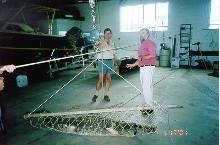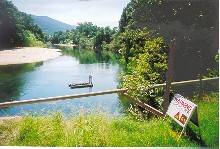| |
|
Estuarine crocodiles, Crocodylus porosus, were hunted almost to extinction. In 1974, at a time when many of the world's croc species were in trouble, hunting was banned in Queensland.
Generally populations of estuarine crocodiles in northern Australia have since recovered (although between Tully and Cooktown, populations are still depleted). This means that crocs have returned to wetlands and waterways which, today, are close to where people live or recreate.
So with our growing population and increasing accessibility to once-remote areas, it is not surprising that human encounters with crocs have dramatically increased. |

Croc researchers measure, weigh and sometimes
tag crocodiles to help us to find out more about them. |
Human interaction with crocs is fraught with highly contentious issues. Sightings of crocs in populated areas or the rare croc attack usually elicit sensational coverage by the media and strong reactions from the public. Headlines, editorials and letters to the editor inevitably call for eradication of crocs, establishment of croc-free zones or the reintroduction of legalised hunting.
On the other side of the debate, crocs are considered to be of special conservation value. They are the top predator in their food chain. They have commercial value for their meat, skins and as tourist attractions and, for many Indigenous peoples, social, spiritual and cultural importance as well. These diverse issues and values associated with crocodiles together with the fascination they hold for children and adults alike makes them an ideal subject for cross-curricula studies, in particular SOSE curricula.
|
Objectives
The objectives of this kit are to:
- develop students' understanding of the ecology of estuarine crocs and their role in the natural system
- enhance students' appreciation of the dangers posed by crocs and how to live safely in croc habitat
- develop students' understanding of the issues related to conservation and management of crocs by indigenous and non-indigenous people
- extend students' ability to make informed decisions about and clarify their values towards crocodile issues
|

Croc warning signs and traps are placed in all waterways close to urban centres where
there are known crocs. |
How to use this kit
This kit is an integrated unit of work designed for students of Years 5-7. It incorporates Information Sheets for students written in a range of genres, and activities for teachers that encompass the key learning areas of Studies of Society and Environment (SOSE), English, Science, Maths, Visual Arts, Drama and Music.
The information and related activities are not intended to be prescriptive or conclusive. As teachers, you will no doubt add, delete or adapt activities and resources as you see fit. The sequencing of activities presented here is only one possible format. You should develop this unit of work to meet your students' needs and interests. The time frame for this unit of work is also at your discretion.
|
How to use the video
(now available online)
The video, provides an additional resource that can be integrated throughout your unit of work. The video focuses on different attitudes to crocs and how people's relationship with crocs has changed over time.
Specifically the video relates to these sections of the kit:
- croc conservation
- managing crocs
- crocs on show
|
|
video online (requires Windows Media Player 6.4 or higher)
Note: You may need to wait some time for the video to buffer before it begins to play
Full video (9m 42s) - 56K modem view download 3.46 Mb
clips
- crocs role in Indigenous culture (including vision of croc feeding and close ups) (47 secs, 344 K) view
- safety messages about no swimming, boating in croc habitats (14 secs, 109 K) view
- Close call! (24 secs, 180 K) view
- historical vision of croc hunting, hanging up carcass, and sorting skins (42 secs, 308 K) view
|
|
 |
© Copyright 2000
Marine Education Society of Australasia
Wildlife Preservation Society of Qld |
 |
croc features |
|